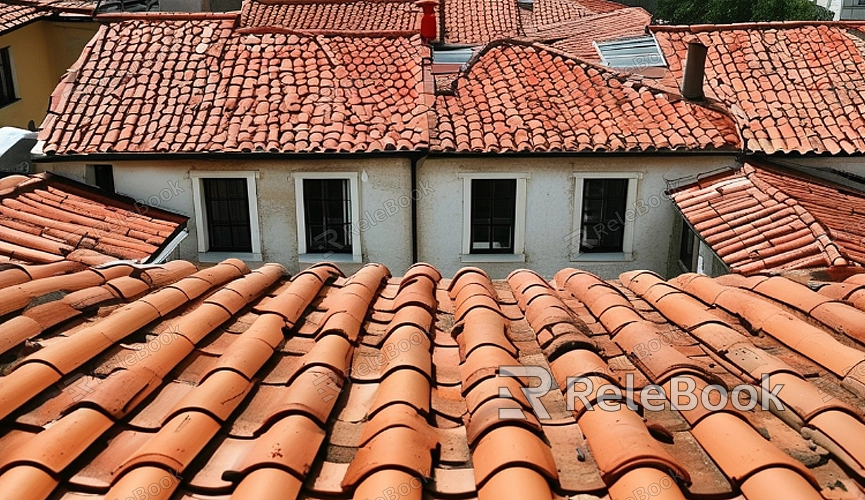How to Model 3D Roof Tiles?
In architectural design and landscape planning, roof tiles are a crucial element. Roofs not only protect buildings from weather conditions but also play a significant role in the aesthetic appeal of a structure. In modern 3D modeling software, creating an accurate 3D roof tile model helps designers effectively showcase their concepts and enhance visual impact. This article will explore how to model roof tiles in 3D software, providing practical tips and advice to improve your modeling skills.

Understanding Types and Structures of Roof Tiles
Before starting the modeling process, it’s essential to understand the various types of roof tiles and their structures. Roof tiles come in many forms, including ceramic tiles, asphalt shingles, metal tiles, and concrete tiles. Each type has distinct shapes, materials, and installation methods.
1. Ceramic Tiles
Ceramic tiles typically feature elegant curved shapes that effectively channel water and possess high durability in sunlight. When modeling, it’s important to consider their smooth surface characteristics.
2. Asphalt Shingles
Asphalt shingles are commonly found in residential buildings and come in various shapes, making them easy to install. Their flat surfaces can be modeled using simple rectangular or triangular shapes.
3. Metal Tiles
Metal tiles are often used in commercial buildings or modern homes due to their strong weather resistance. When modeling, using a metallic texture can enhance the realism of the design.

Choosing Modeling Software
Selecting the right modeling software is critical before beginning roof tile modeling. Common software options include SketchUp, Blender, and 3ds Max. Each has unique advantages, so choose based on personal needs and familiarity.
1. SketchUp
SketchUp is user-friendly, making it suitable for beginners. Its intuitive interface and rich toolset simplify the modeling process. For roof tile modeling, SketchUp offers powerful Push/Pull and texture tools.
2. Blender
Blender is a robust open-source modeling software, ideal for users needing greater flexibility and complex modeling. Its sculpting tools and material editing functions are well-suited for creating intricate roof tile models.
3. 3ds Max
3ds Max is a professional 3D modeling software widely used in architectural visualization and animation. Its powerful rendering capabilities and plugin support make it suitable for detailed roof tile modeling.
Creating Basic Shapes for Roof Tiles
Regardless of the software used, creating the basic shapes of roof tiles is the first step in modeling. Select appropriate geometric shapes based on the type of tiles.
1. Using Rectangles or Triangles
For most roof tiles, rectangles or triangles are common foundational shapes. Use the rectangle tool to outline the bottom profile of the tile, then apply the Push/Pull tool to convert it into a 3D shape.
2. Creating Curved Shapes
For modeling ceramic tiles or other curved shapes, you can use Bézier curve tools or extrusion tools to create smooth curves. Adjusting control points allows for achieving the desired curvature.
3. Combining Multiple Tiles
During modeling, you often need to create multiple tiles and combine them. This can be achieved by copying and arranging the tiles to ensure gaps between them reflect real-life installations.
Applying Textures and Materials
The appearance of roof tiles relies not only on their shapes but also on the choice of textures and materials. Proper texture application can significantly enhance the realism of the model.
1. Choosing Suitable Materials
Start by selecting appropriate materials for the roof tiles during the modeling process. For instance, ceramic tiles can use a glossy reflective material, while asphalt shingles may suit a matte finish.
2. Importing Texture Images
Many modeling software applications support importing custom textures. Users can download texture images from the internet and apply them to the model’s surface. Ensuring that textures match the shape and color of the tiles is key to achieving the desired effect.
3. Adjusting Texture Scale
After applying textures, you may need to adjust their scale and orientation to ensure they display naturally on the tiles. Texture editing tools allow for easy adjustments.
Refining the Model and Adding Details
After creating the basic shapes and applying textures, refining the model is crucial for enhancing the overall effect. Adding details makes the roof tile model more realistic and vibrant.
1. Adding Shadows and Highlights
Adjusting lighting settings allows you to add shadows and highlights to the model, enhancing its three-dimensionality. The proper placement of light sources can improve the tiles' depth and texture.
2. Adding Edge Details
Using sculpting or subdivision tools, you can add subtle bump details to the edges of the tiles, making the model look more natural and authentic.
3. Creating Various Tile Styles
To increase design diversity, consider creating different styles of tiles, such as varying colors, shapes, or textures. Diverse designs enhance the visual appeal of the entire roof.
Finalizing the Model and Rendering
Once all steps are complete, rendering the model can bring it to life. Choosing the right rendering engine allows you to showcase the tile model's details and lighting effects.
1. Selecting a Rendering Engine
Different rendering engines significantly affect the final output. Common rendering engines include V-Ray, Corona, and Lumion. Choosing one that meets your needs can produce higher visual quality.
2. Rendering Settings
Before rendering, users need to adjust settings such as light sources, shadow effects, and material reflections. Tuning these factors helps achieve the best rendering results.
3. Saving and Exporting the Model
After rendering, be sure to save and export the model for future use or sharing. Select an appropriate file format for easy opening and editing in other software.
By mastering the basic structure of roof tiles, selecting suitable modeling software, creating basic shapes, applying textures, refining models, and rendering, designers can effectively enhance their modeling capabilities. Through continuous exploration and the application of new techniques, your work will become even more impressive. For a rich variety of 3D models and textures, feel free to visit the Relebook website to download resources and support your design journey.
FAQ
How do I choose the right modeling software?
The choice of modeling software should be based on individual modeling needs and familiarity. SketchUp is suitable for beginners, Blender offers greater flexibility, and 3ds Max is ideal for professionals.
Where can I find textures for roof tiles?
Users can find various roof tile textures online, with many resource websites offering high-quality free texture downloads.
How do I adjust the scale of a texture?
In most modeling software, after selecting a texture, there are options available to adjust its scale and orientation to ensure it displays naturally on the tiles.
What should I pay attention to when rendering?
During rendering, consider lighting settings, shadow effects, and material reflections, as these factors will influence the final rendering quality.

